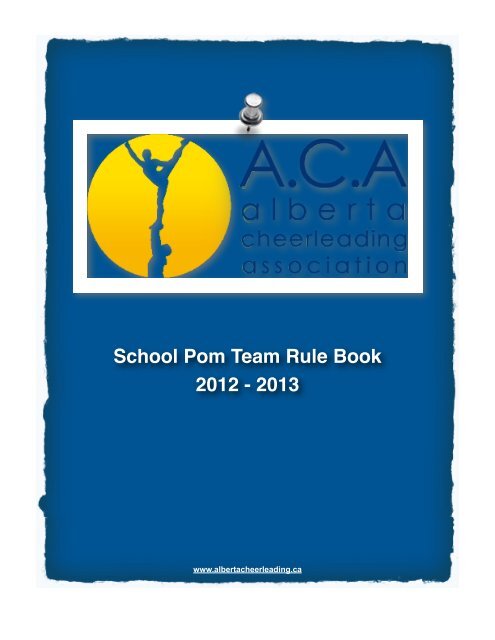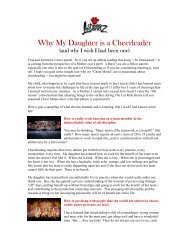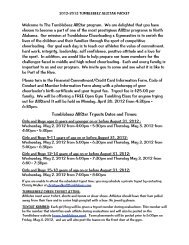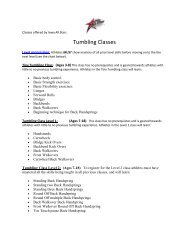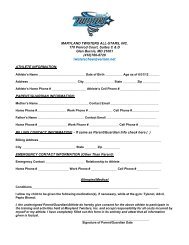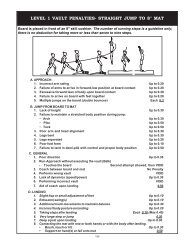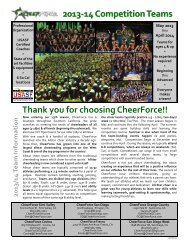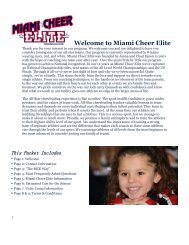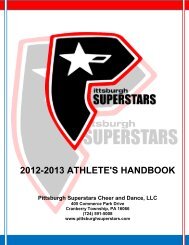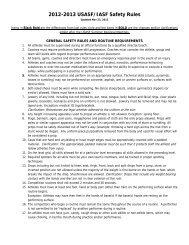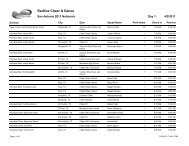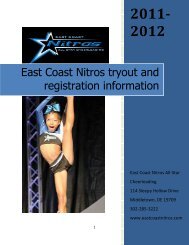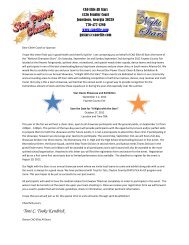School Pom Rule Book 2012 - 2013 - JAMSpiritSites.com
School Pom Rule Book 2012 - 2013 - JAMSpiritSites.com
School Pom Rule Book 2012 - 2013 - JAMSpiritSites.com
Create successful ePaper yourself
Turn your PDF publications into a flip-book with our unique Google optimized e-Paper software.
<strong>School</strong> <strong>Pom</strong> Team <strong>Rule</strong> <strong>Book</strong><br />
<strong>2012</strong> - <strong>2013</strong><br />
www.albertacheerleading.ca
COMPETITION POLICY<br />
SECTION 1- GENERAL<br />
1. The A.C.A rules and regulations will stand for one <strong>com</strong>petitive season. At the conclusion of each season, the<br />
A.C.A Executive will contact the NFHS and USASF / IASF to determine what, if any changes have been made<br />
to their policies for the up<strong>com</strong>ing season. The A.C.A Executive will make the necessary amendments to the<br />
manual and provide this information to the A.C.A membership.<br />
2. In order to be judged at an A.C.A. event, a team must purchase an A.C.A. membership*. Each school /<br />
organization may purchase up to 2 memberships. Memberships must be purchased by December 15th of<br />
each year in order to <strong>com</strong>pete that season (the following January – April). Late memberships can be<br />
purchased for double the regular membership fee no later than February 15th. Membership forms are<br />
available at www.albertacheerleading.ca .<br />
NOTE: This does not apply to teams from outside Alberta.<br />
3. A school team must have a school board employee or school board designate, 19 years or older, designated<br />
as the coach / advisor who will:<br />
a) Ac<strong>com</strong>pany the team to all A.C.A. events<br />
b) Sign all registration forms and sign in at all A.C.A. events<br />
c) The school board designate must have a letter signed by the school principal stating that he/she is<br />
responsible for the teamsʼ activities. This letter is to be submitted to the A.C.A. with the Team<br />
Membership Registration Forms by December 15th of that year.<br />
NOTE: Failure to submit this information will result in the team being unable to <strong>com</strong>pete at A.C.A<br />
events for the season.<br />
4. All supervising <strong>School</strong> cheer coaches must be certified in the following:<br />
a) First Aid<br />
b) CPR<br />
c) ACA Coachesʼ Cheer Certification – Up to the 2level they are coaching<br />
5. All supervising All Star cheer coaches must be certified in the following:<br />
a) USASF/ IASF - Up to the level they are coaching<br />
b) First Aid<br />
c) CPR<br />
6. All supervising <strong>School</strong> and All Star pom/dance coaches must be certified in the following:<br />
a) ACA Coachesʼ <strong>Pom</strong>/dance Certification<br />
b) First Aid<br />
c) CPR<br />
A copy of the certification documents must be submitted to the A.C.A by December 15th of that year with the Team /<br />
Membership Form. Failure to do so will result in that team being unable to <strong>com</strong>pete at ACA events for the season.<br />
7. Coaches should be familiar with the A.C.A. Code of Conduct / Ethics. Coaches who violate this policy may:<br />
" a) Receive a warning letter from the A.C.A, a copy of which will be sent to the <strong>School</strong> Principal and the<br />
" " A.S.A.A or, in the case of All Star programs, a copy will be sent to the Club owner.<br />
d) Be required to appear before an Ethics Committee <strong>com</strong>prised of the A.C.A President, the A.C.A<br />
Judging Director, a non-Executive Member at Large and a certified teacher if a school team is involved<br />
to determine an appropriate course of action.<br />
" Alberta Cheerleading Association <strong>School</strong> <strong>Pom</strong> <strong>Rule</strong> <strong>Book</strong> <strong>2012</strong> - <strong>2013</strong>" 2
8. An approved <strong>com</strong>petition floor will consist of carpeted gymnastics mats and be at least 42ʼ x 42ʼ in dimension.<br />
The mats must be set vertically (front to back) and use white tape or velcro to mark the center mat at the front<br />
and back.<br />
9. <strong>School</strong> teams traveling to Alberta for <strong>com</strong>petition must follow A.C.A. rules and policies.<br />
10. All Star/Club teams traveling to Alberta for <strong>com</strong>petition must follow USASF / IASF rules and policies.<br />
11. A medical advisor (i.e. Saint Johnʼs Ambulance or an athletic therapist) must be provided by the event host.<br />
The Head Judge reserves the right to cancel or postpone an event if medical advisors are not in attendance.<br />
12. At the discretion of the host, registration fees may or may not be refunded if a team withdraws from an event.<br />
In addition, a penalty may be assessed for pulling out of events after the registration deadline.<br />
13. All star/club teams must provide proof of insurance to the A.C.A. This document must be submitted to the<br />
A.C.A. by teams within Alberta by December 15th of that year with the Team Membership Forms. Teams<br />
traveling to Alberta from out of Province must provide this information with the event registration documents.<br />
NOTE: Failure to do so will result in that team being unable to <strong>com</strong>pete at A.C.A. events for the<br />
season.<br />
14. All school teams must wear uniforms that cover their midriff when standing at attention.<br />
15. Coaches are permitted on the <strong>com</strong>petition floor but may not physically assist any athlete at <strong>com</strong>pleting a skill<br />
or the routine. The only exception is if an athlete is falling from a stunt or skill, they may catch them to prevent<br />
injury from occurring.<br />
SECTION 2- PERFORMANCE<br />
1. Teams in a performance only category must follow age/grade appropriate A.C.A. rules / policies.<br />
2. For events not registered through the A.C.A., event hosts who are not using the A.C.A. Registration system<br />
must provide an order of performance to the A.C.A. Judging Coordinator ten (10) days prior to the event date.<br />
Should the event time/order of performance change, the Judging Coordinator must be informed immediately.<br />
3. Teams are not permitted to change divisions for <strong>com</strong>petitions after the order of performance draw has been<br />
made.<br />
4. Changes may be made to the order of performance at the discretion of the Host in consultation with the<br />
Judging Coordinator up to 48 hours prior to the event. Changes to the order of performance will not be made<br />
later than 48 hours prior to the event, with the exception of a teamʼs withdrawal from an event.<br />
5. Routine Stoppage Policy:<br />
INTERRUPTION OF PERFORMANCE:<br />
A routine may be stopped for one of the following reasons:<br />
a) Detection of Alcohol or Illegal Substances:<br />
If it is detected by the Head Judge or Safety Judge that a member or members of a team have<br />
consumed alcohol or other illegal substances prior to performance, the team will be disqualified by the<br />
Head Judge. If consumption of alcohol or illegal substances are reported by another source (i.e. a<br />
coach, event coordinator or athlete) and confirmed by the Head Judge or Safety Judge, the team will<br />
be disqualified by the Head Judge and relevant event fees will not be refunded to the team.<br />
b) Routine is unsafe:<br />
If a teamʼs performance is deemed to be unsafe and/or potentially dangerous, the Head Judge or<br />
Safety Judge will stop the routine and the team will not be allowed to resume their performance.<br />
" Alberta Cheerleading Association <strong>School</strong> <strong>Pom</strong> <strong>Rule</strong> <strong>Book</strong> <strong>2012</strong> - <strong>2013</strong>" 3
c) Technical Problems:<br />
If a technical problem occurs regarding event equipment or facilities, such as sound equipment, mats,<br />
lighting etc., the Head Judge or Safety Judge will stop the routine. If a coach deems it necessary to<br />
stop the routine due to difficulty with the sound system (i.e. music skips, starts on the wrong track or<br />
has incorrect volume) or any other concern regarding technical equipment or facilities, he or she must<br />
approach the Safety Judge.<br />
d) Athlete Injury:<br />
If an athlete is injured seriously enough to warrant discontinuing the routine, meaning that the athlete<br />
is physically unable to continue performing, the Head Judge or Safety Judge will stop the routine. A<br />
coach may also choose to stop the routine due to injury and must approach the Safety Judge in order<br />
to do so.<br />
NOTIFICATION OF PERFORMANCE STOPPAGE:<br />
a) In the event that the Head Judge or Safety Judge intends to stop a routine due to an occurrence outlined<br />
above, they must make an obvious gesture to notify athletes on the floor to stop performing and notify the<br />
Coach immediately of the reason(s) for stopping the routine.<br />
b) In the event that the Coach intends to stop a routine due to an occurrence outlined above, the Coach must<br />
approach the Safety Judge who will advise the Head Judge. Again, the Head Judge or Safety Judge must<br />
make an obvious gesture to notify athletes on the floor to stop performing.<br />
If a performance is discontinued, the Event Coordinator will be notified of the reason for the routine stoppage<br />
and will make an announcement to the spectators at the event outlining the occurrence and whether or not the<br />
team will repeat their routine.<br />
RESUMING PERFORMANCE:<br />
If a performance is discontinued due to a circumstance outlined in Section I (c) or (d), the following protocol<br />
will be followed:<br />
a) If the team chooses NOT to perform again, the judgeʼs scores to the point of the routine stoppage will<br />
stand or the team may withdraw from the <strong>com</strong>petition entirely. In this case, any relevant event fees<br />
will not be refunded to the team.<br />
b) If the team chooses to perform again, the Head Judge, Safety Judge, Coach and Event Cocoordinator<br />
will determine when it is appropriate for the team to do so.<br />
c) If the team chooses to perform again, they must perform the entire routine from the beginning with all<br />
elements included.<br />
d) If the team chooses to perform again, Judges will begin their evaluation from the point of the stoppage<br />
as determined by the Head Judge.<br />
e) If the team chooses to perform again, all penalties assessed prior to the stoppage will stand. It should<br />
be noted that when performing a second time, a team will not be penalized twice for the same error<br />
(i.e. a top falls and is penalized during the first performance and, during the second performance, the<br />
same top falls from the same element; this will not result in a second penalty being assessed).<br />
NOTE: Please note that this policy attempts to account for all possible situations that may arise, however, if<br />
an unforeseen event occurs that is not outlined in this policy, the Head Judge will evaluate the situation and<br />
determine the appropriate course of action. Questions regarding the determined out<strong>com</strong>e should follow the<br />
standard chain of <strong>com</strong>mand: the Head Judge, Judging Coordinator, President.<br />
" Alberta Cheerleading Association <strong>School</strong> <strong>Pom</strong> <strong>Rule</strong> <strong>Book</strong> <strong>2012</strong> - <strong>2013</strong>" 4
SECTION 3 - JUDGING<br />
1. All judges must have participated in a recognized judging clinic and / or be certified by the A.C.A Judging<br />
Coordinator within the current <strong>com</strong>petition season in order to be eligible to judge.<br />
a) The A.C.A. is responsible for scheduling judges at events and in appropriate divisions based on<br />
judging experience, a personʼs cheerleading experience, and their performance at a training clinic.<br />
2. All tabulators will be trained by an A.C.A. Judging Coordinator.<br />
3. The A.C.A. Judging Coordinator shall schedule judges for all events.<br />
4. Teams may request clarification regarding routine skills by contacting the A.C.A. Judging Coordinator no later<br />
than 5 days prior to the event at which the skills will be performed. There are four (4) ways to request / receive<br />
clarification:<br />
a. Call the Judging Coordinator<br />
b. Email the Judging Coordinator<br />
c. Meet with the Judging Coordinator in person<br />
d. Submit a video clip of the skill(s) in question ensuring that the video depicts several different angles of<br />
the elements<br />
NOTE: Due to time and geographical location constraints, the submission of a video clip is re<strong>com</strong>mended as the best<br />
method for requesting clarification.<br />
Please be advised that even if a stunt has been approved by the Judging Coordinator should the execution of that skill<br />
change or the stunt be varied from its approved version the stunt may be deemed illegal by the safety judge during<br />
<strong>com</strong>petition.<br />
5. Competition results will be posted on the ACA website no later than 72 hours following the <strong>com</strong>pletion of an<br />
event. A copy of the rank sheet for their respective division will be attached to each teamʼs score sheets or<br />
posted in an area designated by the event host.<br />
6. Scoring Process: Teams will be judges by 5 panel judges and 1 safety judge/timer, an additional safety judge<br />
will also be present during warm-up times for rule infractions. To calculate a team's final score, the high and<br />
low scores of the panel judges will be dropped and the remaining 3 scores will be added together. From this<br />
total all penalties will be deducted to get the final score.<br />
7. Tie Breaker Policy:<br />
a. The team with fewer penalties<br />
b. The high score added in<br />
c. The low score added in<br />
If the teams are still tied, they will be considered tied in the final rankings.<br />
SECTION 4 - JUDGING APPEALS POLICY<br />
All judging decisions are final. If you have a concern regarding the judging results, the following steps should be<br />
taken:<br />
1. Within 5 days of the <strong>com</strong>petition, submit, via e-mail, a letter expressing your concerns to the ACA Judging<br />
Coordinator. This letter must also be ccʼd to the ACA President and the teacher advisor and/or principal or<br />
gym owner of the coach/school/gym expressing the concern.<br />
" Alberta Cheerleading Association <strong>School</strong> <strong>Pom</strong> <strong>Rule</strong> <strong>Book</strong> <strong>2012</strong> - <strong>2013</strong>" 5
2. The Judging Coordinator will address your concerns in a letter within 7 days after receiving the <strong>com</strong>plaint, after<br />
she consults with the judges and/or persons concerned. This response will also be sent to those individuals<br />
ccʼd in the original <strong>com</strong>plaint letter.<br />
Concerns or <strong>com</strong>plaints must always be addressed in writing. Verbal <strong>com</strong>plaints are strongly discouraged. Direct<br />
confrontation of the judges or Judging Coordinator is considered inappropriate and is strongly discouraged. Such<br />
actions could result in suspension from future A.C.A. events.<br />
For Provincial <strong>com</strong>petition an appeal may be made to the A.S.A.A. Please contact the A.S.A.A. Commissioner for<br />
cheerleading for information on this process.<br />
NOTE: Teachers must always follow the ATA Code of Conduct<br />
" Alberta Cheerleading Association <strong>School</strong> <strong>Pom</strong> <strong>Rule</strong> <strong>Book</strong> <strong>2012</strong> - <strong>2013</strong>" 6
SCHOOL POM TEAM DIVISIONS & GENERAL RULES<br />
SECTION 1- DIVISIONS<br />
The A.C.A. recognizes the following <strong>com</strong>petitive divisions for cheerleading. Only these divisions will be judged by<br />
ACA judges unless special arrangements are made.<br />
NOTE: Not all events offer all divisions. If a division does not have at least 3 teams entered, the host may<br />
cancel that division.<br />
<strong>Pom</strong> Divisions Grade Female/Male Number on Squad<br />
Junior High <strong>Pom</strong> 7 - 9 N/A 4 - 24 athletes<br />
Senior High <strong>Pom</strong> 10 -12 N/A 4 - 24 athletes<br />
WHEN TO SPLIT DIVISIONS:<br />
JUNIOR HIGH & SENIOR HIGH SMALL/LARGE SPLITS Event hosts may split the division into "Small" and "Large"<br />
divisions when there are at least three teams that will ultimately be registered in each respective division. The<br />
designation of "Small" and "Large" divisions must follow the team sizes below:<br />
Small = 4 - 15 members<br />
Large = 16 - 24 members<br />
A/B SPLITS * Applies to Elementary, Jr High and Sr High<br />
If after splitting divisions into "Small" and "Large" there are 10 or more teams in the "Small" or "Large" division, then<br />
event hosts may split that division further by squad size. If splitting further by size, then event hosts must use a name<br />
such as "Division A", "Division B" to denote the split and must clearly define the number of <strong>com</strong>petitors permitted on<br />
the team for each of these particular divisions. No division may be subdivided further from the "Small" (4-15) and<br />
"Large" (16-24) classification if it means that only one team will be left in a division.<br />
SECTION 2- ROUTINE PARAMETERS<br />
1. Time begins with the first obvious word, motion, stunt, or beat of music and will stop when it is obvious to the<br />
officials (with the last stunt, motion, or beat of music).<br />
NOTE: Timing of the routine will stop, but the safety judges will continue judging until they leave the<br />
floor. Safety judges can still deduct for infractions after the timing has stopped.<br />
2. The routine time limit is 2 minutes 30 seconds straight time duration.<br />
SECTION 3- GENERAL COMPETITION RULES<br />
1. Fingernails, including artificial nails, must be kept at an appropriate length (short, near the end of the fingers)<br />
to minimize risk for the participants.<br />
2. The hair must be worn in a manner to minimize risk for the participant. Hair devices, if worn, must be secure<br />
and appropriate for the activity.<br />
3. Apparel and accessories must be appropriate for the activity involved to minimize risk for the participants.<br />
4. A participant in full head and / or body costume must not spot or stunt except for a forward roll or cartwheel.<br />
" Alberta Cheerleading Association <strong>School</strong> <strong>Pom</strong> <strong>Rule</strong> <strong>Book</strong> <strong>2012</strong> - <strong>2013</strong>" 7
5. When standing at attention, apparel must cover the midriff.<br />
6. Glitter that does not readily adhere on the hair, face, uniform, costume or the body is illegal. Glitter may be<br />
used on signs, props or backdrops if laminated or sealed.<br />
7. Supports, braces, etc., which are hard and unyielding or have rough edges or surfaces must be appropriately<br />
covered. A participant wearing a cast (excluding a properly covered air cast) must not be involved in a stunt.<br />
8. A single partial/whole manufacturerʼs logo/trademark (no more than 2 ¼ square inches with no dimension<br />
exceeding 2 ¼ inches) is permitted on the apparel.<br />
9. A flag, not to exceed 2 by 3 inches, and either a <strong>com</strong>memorative or memorial patch, not to exceed 4 square<br />
inches, and with written association approval, may be worn on the uniform/costume.<br />
10. The Judging Coordinator may authorize the use of artificial limbs which in its opinion are no more dangerous<br />
to participants than the corresponding human limb and do not place an opponent at a disadvantage.<br />
11. Cheerleading apparel MUST be conducive to safe performance. The safety judge has the right to check any<br />
participant for jewelry or other potentially unsafe attire. The following items are considered unsafe for<br />
<strong>com</strong>petition:<br />
o False eyelashes<br />
o High heeled<br />
o Unsafe hair accessories<br />
o Gum<br />
o Pins on uniforms<br />
o Other items deemed unsafe by the safety judge. Please check with the Judging Coordinator or Head<br />
Judge prior to the <strong>com</strong>petition for clarification<br />
SECTION 5- ELIGIBILITY<br />
1. Each <strong>com</strong>petitor must be enrolled at the school he/she is <strong>com</strong>peting for, at the time of <strong>com</strong>petition and must<br />
<strong>com</strong>pete on one team for one school for the <strong>com</strong>petition season. However, in the event that a school is<br />
unable to field a team, individuals may participate on another schoolʼs team within their A.S.A.A. Zone.<br />
Students from more than one school within the same zone may form a single <strong>com</strong>petitive team. Participation<br />
of this nature on a High <strong>School</strong> team may only occur with the consent of the participating school Principals, the<br />
Athletic Directors, and the respective A.S.A.A. Zone Director. At the Junior High <strong>School</strong> level and for all <strong>Pom</strong><br />
divisions, participation can only occur with the mutual consent of the two school Principals, the A.C.A Junior<br />
High Director/<strong>Pom</strong> Director and the A.C.A President.<br />
2. Grade 9 students who are registered as students of an ASAA member school, regardless of classification, are<br />
eligible to participate on the <strong>com</strong>petitive school team with the consent of the Principal and Athletic Director.<br />
This includes A.S.A.A. Zone and Provincial <strong>com</strong>petitions.<br />
3. Grade 6 students who are registered as students of a junior high school or a middle school (grades 5-8, 5-9, or<br />
6-9) may participate on their schoolʼs Junior Highʼs Cheer team.<br />
4. Grade 4 students who are registered as students of an “early years” school, where the highest grade at the<br />
school is grade 4, may participate on their schoolʼs Elementary Division 1 team.<br />
5. Athletes who are participating on a High <strong>School</strong> Cheer team are not permitted to participate on an All Star/<br />
Club team during the same season of play.<br />
6. Post Secondary athletes must be a registered student at the <strong>com</strong>peting school in the term of <strong>com</strong>petition.<br />
" Alberta Cheerleading Association <strong>School</strong> <strong>Pom</strong> <strong>Rule</strong> <strong>Book</strong> <strong>2012</strong> - <strong>2013</strong>" 8
SECTION 6 - RULE INFRACTIONS POLICY<br />
FALL DEDUCTIONS<br />
Fall: If an athlete trips and falls or bumps into another athlete while moving and falls to the ground a 5 point penalty<br />
will NOT be assessed.<br />
Stunt Fall:<br />
- Controlled Fall - A stunt fall is deemed controlled if the athlete lands in a cradle position with no body parts<br />
hitting the floor, or when an athlete is slowed to their feet by the bases.<br />
- Uncontrolled Fall - A stunt fall is deemed uncontrolled if an athlete falls to the floor, either a top or a base, or<br />
if an athlete lands on there feet with very little to no support from the bases. If an entire stunt group falls to<br />
the floor only one 5 point penalty is assessed, not per athlete.<br />
***It is the sole discretion of the Head and Safety judges to determine whether a fall will be considered a controlled fall<br />
or an uncontrolled fall.<br />
Jump Fall: A 5 point penalty will only be assessed when a body part other than the athletes hands and feet hit the<br />
floor.<br />
Tumbling Fall: A 5 point penalty will only be assessed when a body part other than the athletes hands and feet hit the<br />
floor.<br />
OTHER 5 POINT INFRACTIONS<br />
• Inappropriate choreography/music<br />
• Unsportmanlike language<br />
• Unsafe or otherwise unapproved use of clothing and/or props<br />
• No visual/physical contact<br />
NON-CHOREOGRAPHED ERROR<br />
Non-Choreographed Error: If a skill be<strong>com</strong>es illegal due to an OBVIOUS execution error a 5 point deduction will be<br />
taken.<br />
" Eg. during a lift the supporting dancer loses contact with the executing dancer as the lift falls. Only one 5 point<br />
deduction will be taken off for the fall an NO deduction for a rule infraction because it was the fall that caused the skill<br />
to be illegal. It was OBVIOUS to the judges that it was not choreography that way.<br />
"<br />
20 POINT RULE INFRACTIONS<br />
All teams must follow the rules in there division from the moment they set foot on the mat until the time in which they<br />
step off. Failure to do so will result in a 20 point infraction. Should a team, after being given a 20 point deduction<br />
continue to perform the same illegal skill the safety judge has the right to disqualify that team. A team who is<br />
performing only or is the only team in there division must still follow the rules of there division. Should any coach<br />
willfully disregard the rules as set out by the ACA membership there Coaches Certification can be put up for review by<br />
the ACA executive with the possibility of it being revoked.<br />
WARNINGS<br />
Warnings shall only be given if the safety judge is at all unsure of the skill performed. For example if there was an<br />
intentional rule infraction or if it was a non-choreographed error. Warnings MAY also be given at the beginning of the<br />
season for rules that are new to the rule book or that have been altered in such a way to that there meaning has<br />
changed. Giving a warning vs. a rule infraction is solely the discretion of the safety judge.<br />
A.C.A. WARM-UP MAT SAFETY JUDGE POLICY<br />
" At the request of the event host a safety judge may be present on the warm-up mat prior to <strong>com</strong>petitions.<br />
During that time the safety judge can be asked rule clarification questions and view specific routine portions at the<br />
request of the coach. The assigned judge will also be keeping an eye on warm-ups to look for any rule infractions.<br />
Should the safety judge see an infraction, he/she will notify the coach immediately. The safety judge will not be in<br />
contact with the safety judges that are judging performances so it is up to the coaches whether to change the routine<br />
or <strong>com</strong>pete with the illegal skill. This is a decision that must be carefully made by the coaches with the athletes safety<br />
in mind. The safety judge is there as an advisor to the coaches should they request the judges assistance. If the safety<br />
" Alberta Cheerleading Association <strong>School</strong> <strong>Pom</strong> <strong>Rule</strong> <strong>Book</strong> <strong>2012</strong> - <strong>2013</strong>" 9
judge does not see a rule infraction on the warm up mat this does not indemnify the team from receiving a penalty on<br />
the <strong>com</strong>petition mat. The safety judge will do there best to provide assistance and look for any infractions while teams<br />
are in the warm-up area.<br />
" Alberta Cheerleading Association <strong>School</strong> <strong>Pom</strong> <strong>Rule</strong> <strong>Book</strong> <strong>2012</strong> - <strong>2013</strong>" 10
<strong>2012</strong>/<strong>2013</strong> & <strong>2013</strong>/14<br />
USASF Dance<br />
RULES<br />
These USASF Dance <strong>Rule</strong>s are effective from June 1, <strong>2012</strong> to May 31, 2014 and are subject to review by the <strong>Rule</strong>s Committee at any time.<br />
DANCE GENERAL RULES<br />
1. All teams must be supervised during all official functions by a qualified coach/instructor.<br />
2. Coaches/instructors must require proficiency before skill progression. Coaches must consider the dancer<br />
and team skill level with regard to proper performance placement.<br />
3. All participants agree to conduct themselves in a manner displaying good sportsmanship throughout the<br />
event. The director/ coach of each team is responsible for seeing that team members, coaches, parents, and<br />
any other person affiliated with the team conduct themselves accordingly.<br />
4. All programs should have, and review, an emergency action plan in the event of an injury.<br />
5. Teams must have at least 4 members. There is no maximum limit.<br />
6. Each team will have a minimum of 1 minute and 45 seconds (1:45) to a maximum of 2 minutes and 30<br />
seconds (2:30) to demonstrate their style and expertise. Timing will begin with the first choreographed<br />
movement or note of the music. Timing will end with the last choreographed movement or note of the<br />
music, whichever happens last.<br />
a. Event producers may allow a maximum of 5 second leeway/grace period.<br />
b. If a <strong>com</strong>pany adds the production/show category, the time limit may be increased to 5 minutes.<br />
7. Substitutions may be made in the event of any injury or other serious circumstance. Substitutes must also<br />
abide by the age and gender restrictions in all divisions in which they <strong>com</strong>pete.<br />
8. Footwear is re<strong>com</strong>mended but not required. Wearing socks and/or footed tights only is prohibited.<br />
(Exception: socks are allowed on a carpeted performance surface)<br />
9. Jewelry as a part of a costume is allowed.<br />
CHOREOGRAPHY AND COSTUMING<br />
PROPS<br />
BOLD font: Please read these carefully as anything bold is a deliberate change to the guidelines..<br />
Please contact USASF Dance Chair Catherine Morris (cmorris@usasf.net) or Director of Dance: Tegan Reeves (treeves@usasf.net) for further explanation with regards to any of these topics.<br />
1. Suggestive, offensive, or vulgar choreography, costuming, and/or music are inappropriate for family<br />
audiences and therefore lack audience appeal.<br />
2. Routine choreography should be appropriate and entertaining for all audience members. Vulgar or<br />
suggestive material is defined as any movement or choreography implying something improper or<br />
indecent, appearing offensive or sexual in content, and/or relaying lewd or profane gestures or<br />
implications. Inappropriate choreography, costuming and/or music may affect the judges’ overall<br />
impression and/or score of the routine.<br />
3. All choreography should be age appropriate.<br />
4. All costuming and makeup should be age appropriate and acceptable for family viewing.<br />
1. Wearable and handheld items are allowed in all categories and can be removed and discarded from the<br />
body.<br />
2. Standing props are only allowed in the prop and production category. Any item that bears the weight of<br />
the participant is considered a standing prop. (Examples: chairs, stools, benches, ladders, boxes, stairs,<br />
etc.)<br />
-1-
TUMBLING (Executed by individuals)<br />
Tumbling: An acrobatic or gymnastics skill executed by an individual dancer without contact, assistance<br />
or support of another dancer(s) and begins and ends on the performance surface.<br />
Tumbling as a dance skill is allowed, but not required in all divisions with the following limitations:<br />
1. Airborne* tumbling skills with hip over head rotation are not allowed. (Exception: aerials, dive<br />
rolls in a pike position and round offs).<br />
2. Simultaneous tumbling over or under another dancer that includes hip over head rotation by<br />
both dancers is not allowed.<br />
3. Drops* to the knee, thigh, back, seat, front, jazz split (hurdler) or split position onto the performing<br />
surface are not allowed unless the dancer first bears weight on the hands or foot/feet.<br />
4. Drops* to a push-up position onto the performance surface are allowed from a jump with forward<br />
momentum (i.e. Flying Squirrel) or an X, Star or Spread Eagle jump. All variations of a Shushunova<br />
are not allowed.<br />
5. Hip over head rotation skills with hand support are not allowed while holding poms or props.<br />
(Exception: forward rolls and backward rolls are allowed).<br />
DANCE LIFTS AND PARTNERING (Executed in partners or groups):<br />
1. Any Supporting Dancer(s) who has primary weight of an Executing Dancer must maintain direct<br />
contact with the performance surface at all times.<br />
2. At least one Supporting Dancer must have hand/arm/body to hand/arm/body contact with the<br />
Executing Dancer(s) throughout the entire skill above shoulder level.<br />
3. Hip over head rotation of the Executing Dancer(s) is allowed if:<br />
a. A Supporting Dancer maintains hand/arm/body to hand/arm/body contact until the Executing<br />
Dancer returns to the performance surface or returns to the upright position.<br />
b. The skill is limited to one [hip over head] rotation.<br />
4. A Vertical Inversion* is allowed if:<br />
a. The Supporting Dancer(s) maintains hand/arm/body to hand/arm/body contact until the Executing<br />
Dancer returns to the performance surface or returns to the upright position.<br />
b. When the height of the Executing Dancer’s shoulders exceed shoulder level there is at least one<br />
additional dancer to spot and/or support.<br />
RELEASE MOVES<br />
5. An Executing Dancer may jump, leap, step or push off a Supporting Dancer(s) if:<br />
a. The highest point of the released skill does not elevate the Executing Dancer’s hips above shoulder<br />
level.<br />
b. When the height of the skill is at hip level or above the Executing Dancer may not pass through the<br />
prone or inverted position.<br />
c. Toe Pitches are not allowed.<br />
6. A Supporting Dancer may toss an Executing Dancer as long as:<br />
a. The highest point of the toss does not elevate the Executing Dancer’s hips above shoulder level.<br />
b. The Executing Dancer is not prone or inverted when released.<br />
c. The Executing Dancer does not pass through a prone or inverted position after release.<br />
* see glossary definition<br />
(HIP HOP teams in Junior, Senior and Open see also Expanded <strong>Rule</strong>s. Prep Teams see also Limited <strong>Rule</strong>s.)<br />
-2-
LIMITED PREP CATEGORY RULES:<br />
Teams in the Prep category must follow the USASF Dance <strong>Rule</strong>s AND the additional restrictions below:<br />
Prep TECHNICAL SKILLS (executed by individuals):<br />
Skills are developed and should be part of natural progression in learning. The prep category involves skills with<br />
the following limitations:<br />
1. Skill <strong>com</strong>binations are limited to 3 technical skills. (Exception: Chassé and glissade are considered<br />
steps. Clarification: Duplicate skills are considered multiple skills [i.e. double pirouette is 2<br />
skills].)<br />
2. Turns are allowed provided the following:<br />
a) Working leg is held in a passé or coupe position.<br />
b) Supporting leg is on ground through the <strong>com</strong>pletion of the turn.<br />
c) Rotations are limited to 2 rotations.<br />
3. Leaps and jumps are allowed provided the following:<br />
a) Does not involve a position change (Example: switch leaps are not allowed).<br />
b) Do not involve axis rotation (Example: tour jetté or axle is not allowed)<br />
Prep TUMBLING (executed by individuals)<br />
Tumbling, as a dance style skill is allowed, but not required. The prep category must follow the USASF <strong>Rule</strong>s in<br />
addition to the following limitations:<br />
1. Skills with hip over head rotation must involve hand support and may not be airborne. (Example:<br />
airborne skills with hip over head rotation* including roundoffs are not allowed).<br />
2. Skills that do not include hip over head rotation may be airborne provided the following:<br />
a) No more than one axis rotation in a straight/pencil position (Example: A jump full turn is allowed, a<br />
windmill or butterfly is not allowed)<br />
b) Involve hand support during any inversion. (Example: kip ups must have hand support)<br />
3. Inverted skills are allowed provided the following:<br />
a) Involve hand support with at least one hand (Example: shoulder stall)<br />
Prep DANCE LIFTS AND PARTNERING (Executed in partners or groups)<br />
Dance Lifts and Partnering should be limited. The prep category must follow the USASF Guidelines in addition<br />
to the following limitations:<br />
1. All Supporting Dancer(s) must maintain direct contact with the performance surface at all<br />
times.<br />
2. All Supporting Dancer(s) must have hand/arm/body to hand/arm/body contact with the<br />
Executing Dancer(s) throughout the entire lift. (Clarification: The Executing Dancer may not be<br />
released)<br />
3. Executing Dancer must maintain an upright position in any elevated skill.<br />
4. Executing Dancer’s hips cannot elevate about shoulder level.<br />
-3-
EXPANDED HIP HOP RULES (For Junior, Senior, and Open HIP HOP Teams):<br />
Junior, Senior, and Open teams in the Hip Hop category must follow the USASF Dance <strong>Rule</strong>s, but may<br />
apply the exceptions in the Expanded Hip Hop <strong>Rule</strong>s below:<br />
AERIAL STREET SKILLS (Executed by individuals):<br />
1. Airborne skills* with hip over head rotation are permitted provided the following:<br />
a. Skills without hand support may involve no more than one twisting rotation.<br />
** see below for further explanation and exception.<br />
b. Only skills with hand support may be performed consecutively, but are limited to 2 consecutive skills.<br />
(Example: Two back handsprings may connect, an airborne hip over head rotation without hand support<br />
may not connect to any skill or jump)<br />
3. Drops from a turn, jump or inverted position are permitted provided the following:<br />
a. Drops to the shoulder or seat are permitted provided the height of the airborne dancer does not<br />
exceed hip level (Example: kip ups are allowed).<br />
4. Drops to a push up position may involve any jump.<br />
LIFTS AND PARTNERING (Executed in partners or groups):<br />
1. A Supporting Dancer who has primary weight of the executing dancer does not have to<br />
maintain contact with the performance surface provided the height of the skill does not exceed<br />
shoulder level.<br />
RELEASE 5 & 6 : An Executing Dancer may jump, leap, step, push off or be tossed by a Supporting<br />
Dancer(s) if:<br />
a. The highest point of the released skill does not elevate the Executing Dancer’s feet above shoulder<br />
level.<br />
b. The Executing Dancer must either be assisted to the performance surface or land on at least one of<br />
his/her feet.<br />
* see glossary definition<br />
** Aerial Street Skills are Hip Hop skill sets that dancers develop over time. They can include rotation that is hip over head or twisting.<br />
These skills are NOT meant to incorporate gymnastics or cheerleading style tumbling. Such gymnastic skills are NOT ALLOWED. This<br />
prohibits a “standing full twisting layout” in the Expanded Hip Hop <strong>Rule</strong>s but allows a capoeira style “folha secca twist”.<br />
-4-
<strong>2012</strong>-<strong>2013</strong><br />
USASF Dance<br />
GLOSSARY OF TERMS<br />
Updated 6-27-12<br />
Airborne (executed by individual): A state in which the dancer is free of contact from a person and/or<br />
the performing surface.<br />
Airborne Hip Over Head Rotation (executed by individual): An action where hips rotate over the<br />
head in a tumbling skill and there is no contact with the performance surface (Example: Round off or a<br />
Backhandsping).<br />
Airborne Skill (executed by individual): A skill in which the dancer is free of contact with the<br />
performance surface. (Example: Tour Jetté or Butterfly.)<br />
Aerial Cartwheel: An airborne tumbling skill which emulates a cartwheel executed without placing<br />
hands on the ground.<br />
Axle: A turn in which the working leg makes a circle in the air to passé as the supporting leg lifts off the<br />
ground enabling the dancer to perform a rotation in the air and then lands on the original supporting leg.<br />
Back Walkover: A non-airborne tumbling skill where the dancer reaches backward with an arched torso<br />
through an inverted position, hands make contact with the ground, then the hips rotate over the head and<br />
the torso hollows bringing the dancer to an upright position, landing one foot/leg at a time.<br />
Breaking: A style of hip hop dance that incorporates martial arts, acrobatic oriented tricks and dance.<br />
The term for a person who executes this style of dance is known as a BBoy (breaking –boy) or BGirl<br />
(breaking –girl).<br />
C- Jump: A jump in which the dancer creates an arch in the back allowing the knees to bend and the feet<br />
reach behind the body.<br />
Cartwheel: A non-airborne tumbling skill where the dancer supports the weight of the body with the<br />
arm(s) while rotating sideways through an inverted position landing on one foot at a time.<br />
Calypso [ka-lip-SO]: A turning leap in which the working leg extends making a circle in the air as the<br />
supporting leg lifts off the ground enabling the dancer to perform a rotation in the air then the supporting<br />
(back) leg reaches behind the body, often in an attitude, and then lands on the original working leg.<br />
Category: Denoting the style of a performance piece/<strong>com</strong>petition routine. (Example: Jazz, <strong>Pom</strong> or Hip<br />
Hop)<br />
Coed: A Division that includes 1 or more males.<br />
Coupe [koo-PAY]: A position in which one foot is held lifted and close to the ankle. Also known<br />
as Coup de Pied: quickly takes the place of the other; meaning to cut or cutting.<br />
Consecutive Skills: An action in which the dancer connects skills immediately, without step,<br />
pause or break in between. (Example: Double Pirouette or Double Toe Touch)<br />
-1-
Dance Crew: A style of dance, typically seen in the hip hop category, involving a body or<br />
group of dancers who work at a <strong>com</strong>mon style of dance.<br />
Dance Lift (executed as partners or in a group): A skill in which a dancer(s) is elevated from the<br />
performance surface by one or more dancers and set down. A Dance Lift is <strong>com</strong>prised of “Lifting”<br />
dancer(s) and “Elevated” dancer(s). Refer to the USASF/IASF <strong>Rule</strong>s for Dance Lifts and Partnering for<br />
safety guidelines.<br />
Developpé [develop-AY]: An action in which the working leg moves through passé (bends) before<br />
extending into position; meaning to develop.<br />
Dive Roll: An airborne tumbling skill in which the dancer does a forward roll where the hands and feet<br />
are off of the performing surface simultaneously. This skill is allowed only if the dancer is in a pike<br />
position.<br />
Division: Denoting the <strong>com</strong>position of a <strong>com</strong>peting group of dancers. (Example: Senior Coed, Junior and<br />
Youth)<br />
Drop: An Action in which an airborne dancer lands on a body part other than his/her hands or feet<br />
without first bearing weight on the hands/feet.<br />
Elevated: An action in which a dancer is moved to a higher position or place from a lower one.<br />
Elevated Dancer: A dancer who is lifted from the performance surface as a part of a Dance Lift. Refer<br />
to the USASF/IASF <strong>Rule</strong>s for Dance Lifts and Partnering for safety guidelines.<br />
Executing Dancer: A dancer who performs a skill as a part of a Dance Trick or uses support from<br />
another dancer or dancers when Partnering. Refer to the USASF/IASF <strong>Rule</strong>s for Dance Lifts and<br />
Partnering for safety guidelines.<br />
Fouetté [foo-eh-TAY]: A turning step, usually done in a series, in which the working leg makes a circle<br />
in the air and then into passé as the dancer turns bending (plié) and rising (relevé) at each revolution;<br />
meaning to whip. Fouetté turns can also be done to the side or in second position (fouetté a la seconde).<br />
Fouetté a la Seconde: A turning step done in a series in which the working leg makes a circle in the air<br />
and extends at a 90° angle from the supporting leg remaining parallel to the ground as the dancer turns<br />
with a plié and relevé at each revolution.<br />
Flying Squirrel: A jump in which the dancer executes with forward momentum with the dancers arms<br />
extended in front, legs behind, creating an "X" position in the air.<br />
Front Walkover: A non-airborne tumbling skill where the dancer rotates forward with a hollow torso<br />
through an inverted position and arches up bringing the legs and hips over the head to a non-inverted<br />
position legs landing one foot/leg at a time.<br />
Handstand: A non-airborne, non-rotating, tumbling skill where the dancer supports his/herself vertically<br />
on his/her hands in an inverted position and the arms are extended straight by the head and ears.<br />
Head Spin: A skill, typically performed in hip hop, in which the dancer spins on his/her head and uses<br />
his/her hands to aid in speed. The legs can be held in a variety of positions.<br />
-2-
Head Spring (front/back): An airborne tumbling skill, typically performed in hip hop, in which the<br />
dancer approaches the head spring much like a hand spring, and can be executed either to the front or to<br />
the back. Beginning in a standing or squatting position, the hands are placed on the floor with the head<br />
between the hands, and the legs <strong>com</strong>e over/whip through the body similar to a kip up and the dancer lands<br />
on two feet.<br />
Headstand: A non-airborne, non-rotating, tumbling skill where the dancer supports his/herself vertically<br />
on his/her head in an inverted position and the hands are on the floor supporting the body.<br />
Hip Level: A designated height; the height of a standing dancers’ hips while standing upright with<br />
straight legs. (Clarification: this is an approximate height to measure space, and is not changed by<br />
bending, inverting, etc.)<br />
Hip Over Head Rotation (executed by individuals): An action where a dancers hips rotate over the<br />
head in a tumbling skill (Example: Back Walkover or Cartwheel).<br />
Hip Over Head Rotation (executed in groups or pairs) : An action where the Executing Dancers’<br />
hips rotate over the head in a lift or partnering skill.<br />
Inversion: A position in which the dancer’s waist/hips/feet are higher than his/her head and shoulders.<br />
Jetté [juh-TAY]: A skill in which the dancer takes off from one foot by brushing the feet into the ground<br />
and swiftly ‘whipping’ them into the position and then landing on one foot. A jetté can be executed in<br />
various directions, sizes and positions.<br />
Kip Up: An airborne, non-rotating, tumbling skill, typically performed in hip hop, where the dancer<br />
brings the body to a non-inverted (upright) position by bending the knees, thrusting the legs into the chest<br />
rolling back slightly onto the shoulders, and then kicks up. The force of the kick causes the dancer to lift<br />
and land with both feet planted on the floor.<br />
Krumping: A style of dance, hip hop category, ‘street’ dance characterized by free, expressive,<br />
exaggerated, and highly energetic moves involving the arms, head, legs, chest, and feet.<br />
Leap: A skill in which the dancer pushes off the ground, from a plié (bend), off of one leg be<strong>com</strong>ing<br />
airborne and landing on the opposite leg. (also known as grand jetté)<br />
Lifting Dancer: A dancer(s), who is part of a dance lift and lifts an Elevated Dancer as a part of a Dance<br />
Lift. Refer to the USASF/IASF <strong>Rule</strong>s for Dance Lifts, Dance Tricks and Partnering for safety guidelines.<br />
The supporting dancer may also be considered a Lifting Dancer. Refer to the USASF/IASF <strong>Rule</strong>s for<br />
Dance Lifts and Partnering for safety guidelines.<br />
Passé [pa-SAY]: A position or movement in which the working leg bends connecting the pointed foot to<br />
or near the knee of the supporting leg; meaning to pass. Passé can be executed with the hips parallel or<br />
turned out.<br />
Partnering (executed in pairs): A skill in which two dancers use support from one another. Partnering<br />
can involve both “Supporting” and “Executing” skills. Refer to the USASF/IASF <strong>Rule</strong>s for Dance Lifts<br />
and Partnering for safety guidelines.<br />
Pirouette [peer-o-WET]: A skill in which the dancer bends (plié) with one foot in front of the other<br />
(fourth position) and rises (relevé) to one leg making a <strong>com</strong>plete rotation of the body; meaning to whirl.<br />
A pirouette can be executed in a variety of positions.<br />
-3-
Plié [plee-AY]: A preparatory and landing skill in which the dancer bends, softens his/her knees; meaning<br />
to bend.<br />
Prop: An object that can be manipulated. A glove is a part of the uniform.<br />
Prone: A position in which the front of the dancers’ body is facing the ground, and the back of the<br />
dancers body is facing up.<br />
Relevé [rell-eh-VAY]: An executing skill in which the dancer lifts up to the ball of his/her feet; meaning<br />
to rise.<br />
Release Move (executed in groups or pairs): An action in which the Executing Dancer be<strong>com</strong>es free<br />
of contact from Supporting Dancer(s) and are unassisted to the performance surface.<br />
Shoulder Roll (forward/back): A non-airborne tumbling skill where the dancer rolls with the back of the<br />
shoulder and maintains contact with the floor and the head is tilted to the side to avoid contact with the<br />
floor.<br />
Shoulder Level: A designated height; the height of a standing dancers’ shoulders while standing<br />
upright with straight legs. (Clarification: this is an approximate height to measure space, and is not<br />
changed by bending, inverting, etc.)<br />
Shushunova [Shush-A-nova]: A jump variation in which the dancer lifts extended legs to a toe touch or<br />
pike position and then circles them behind the body dropping the chest and landing in a prone support<br />
(push up position).<br />
Stag: A position, typically performed in a leap or jump, in which the dancer bends the front leg.<br />
Stall: A non-airborne, non rotating, tumbling skill typically performed in hip hop where the dancer halts/<br />
stops body mid motion; often in an interesting, inverted or balance-intensive position on one or both<br />
hands for support. Also known as a freeze.<br />
Stepping/Step Dancing: A style of dance, typically hip hop category, which is a form of percussive<br />
dance in which the participant's entire body is used as an instrument to produce <strong>com</strong>plex rhythms and<br />
sounds through a mixture of footsteps, spoken word, and hand claps.<br />
Supporting Dancer: A supporting dancer(s), who part of a dance trick and bears the primary weight of a<br />
lifted dancer. A supporting dancer(s) holds or tosses and/or maintains contact with an Executing dancer as<br />
a part of a Dance Trick or Partnering skill. The supporting dancer may also be considered a Lifting<br />
Dancer. Refer to the USASF/IASF <strong>Rule</strong>s for Dance Lifts and Partnering for safety guidelines.<br />
Supporting Leg: The leg of a dancer that supports the weight of the body, during a skill.<br />
Supine: A position in which the back of the dancers’ body is facing the ground, and the front of the<br />
dancers body is facing up.<br />
Switch Leap: A leap in which the dancer swings her working leg to change the position/direction of the<br />
leap.<br />
Tilt: A skill, typically performed in a leap or jump, in which the working leg sweeps up into the air and<br />
the supporting leg points toward the ground.<br />
Toe Pitch (executed by groups or pairs): A toss in which the Executing Dancer(s) foot is in the hands<br />
of the Supporting Dancer(s) and s/he is propelled upward.<br />
-4-
Toe Touch: A jump in which the dancer lifts the legs through a straddle rotating the hips so that the legs<br />
are rotating up toward the (upright) chest.<br />
Tour Jetté: A skill in which the dancer takes off from one leg, executes a half turn and lands on the same<br />
leg.<br />
Toss: A release move where Supporting Dancer(s) execute a throwing motion to increase the height of the<br />
executing dancer. The Executing Dancer is free from the performance surface when toss is initiated.<br />
Tumbling: A collection of skills that emphasize acrobatic or gymnastic ability, are executed by an<br />
individual dancer without contact, assistance or support of another dancer(s) and begin and end on the<br />
performance surface. (Clarification: tumbling skills do not have to include hip over head rotation)<br />
Vertical Inversion (executed in groups or pairs): A position in which the Executing Dancer is inverted<br />
and bears direct weight on the Supporting Dancer by a stop, stall or change in momentum.<br />
Windmill: A non-airborne, non-rotating, tumbling skill in which a dancer begins on the back, spins from<br />
his/her upper back to the chest while twirling his/her legs around his/her body in a V-shape. The leg<br />
motion gives the majority of the power, allowing the body to “flip” from a position on the back to a<br />
position with the chest to the ground.<br />
Working Leg: The leg of a dancer that is responsible for momentum and/or position, during a skill.<br />
BOLD FONT Please read these carefully as anything bold is a deliberate change to the glossary.<br />
Please contact USASF Dance Committee Chairman Catherine Morris (cmorris@usasf.net ) or USASF Director of Dance Tegan Reeves<br />
(treeves@usasf.net) for further explanation with regard to any of these topics.<br />
-5-


